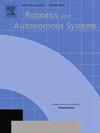基于回波状态网络的外骨骼类脑智能轨迹预测模型设计
IF 4.3
2区 计算机科学
Q1 AUTOMATION & CONTROL SYSTEMS
引用次数: 0
摘要
传统的康复训练方法面临着巨大的挑战,例如可重复性低和技术熟练的医生短缺。外骨骼机器人已被康复专家视为解决这些问题的重要工具。然而,目前的辅助训练设备存在人机交互能力有限、训练模式单一和基本无源功能等问题。为了提高康复训练的效果,尤其是在预测人体运动轨迹方面,本研究提出了一种类脑智能轨迹预测模型。该模型受仿生学启发,遵循人脑的生理结构和控制机制,以改善康复外骨骼中的人机协同控制。该模型利用回声状态网络(ESN),建立了一个反映小脑、脑干和脊髓运动神经元活动的计算框架。结合尖峰小脑模型网络 (SCMN),我们开发了一个类脑轨迹预测模型,其中包含脉冲神经元,模拟生物神经网络中的传输和突触过程。这种方法提高了计算效率和生理学可解释性,解决了现有神经网络模型的局限性。实验结果表明,所提出的类脑控制模型能有效预测上肢康复外骨骼的运动轨迹,为康复机器人的仿生控制提供了新的理论和实践框架。本文章由计算机程序翻译,如有差异,请以英文原文为准。
Design of exoskeleton brain-like intelligent trajectory prediction model based on echo state network
Traditional rehabilitation training methods face significant challenges, such as low repeatability and a shortage of skilled physicians. Exoskeleton robots have been recognized by rehabilitation experts as valuable tools in addressing these issues. However, current auxiliary training devices suffer from limited human-computer interaction capabilities, single-mode training, and basic passive functionalities. To enhance the effectiveness of rehabilitation training, particularly in predicting human movement trajectories, this study presents a brain-like intelligent trajectory prediction model. This model, inspired by bionics, follows the physiological structure and control mechanisms of the human brain to improve human-robot cooperative control in rehabilitation exoskeletons. Utilizing an Echo State Network (ESN), the model establishes a computational framework that mirrors the motor neuron activity of the cerebellum, brainstem, and spinal cord. In conjunction with the Spiking Cerebellar Model Network (SCMN), a brain-like trajectory prediction model was developed that incorporates pulsatile neurons, simulating the transmission and synaptic processes observed in biological neural networks. This approach enhances computational efficiency and physiological interpretability, addressing the limitations of existing neural network models. Experimental results demonstrate that the proposed brain-like control model effectively predicts the movement trajectories of upper limb rehabilitation exoskeletons, offering a novel theoretical and practical framework for bionic control in rehabilitation robotics.
求助全文
通过发布文献求助,成功后即可免费获取论文全文。
去求助
来源期刊

Robotics and Autonomous Systems
工程技术-机器人学
CiteScore
9.00
自引率
7.00%
发文量
164
审稿时长
4.5 months
期刊介绍:
Robotics and Autonomous Systems will carry articles describing fundamental developments in the field of robotics, with special emphasis on autonomous systems. An important goal of this journal is to extend the state of the art in both symbolic and sensory based robot control and learning in the context of autonomous systems.
Robotics and Autonomous Systems will carry articles on the theoretical, computational and experimental aspects of autonomous systems, or modules of such systems.
 求助内容:
求助内容: 应助结果提醒方式:
应助结果提醒方式:


